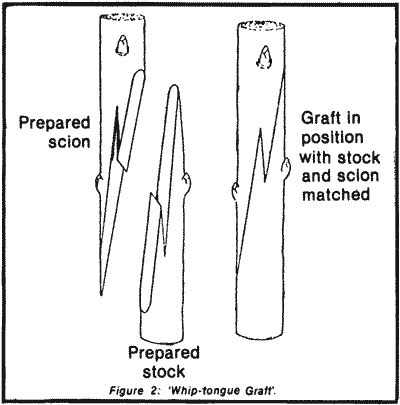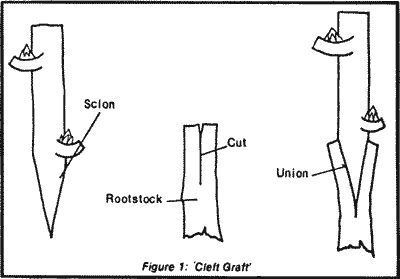
GRAFTING MANGOS
SCIENTIFIC NAME: Mangifera indica
FAMILY: Anacardiaceae
The main mango varieties in Queensland, the Kensington and the Common are polyembryonic and grow true to type from seed.
However, the new varieties recently released by the Department of Primary Industries: Kent, Palmer, Haden, Zill and Carrie, are monoembryonic and have to be propagated by grafting. With a little practice, grafting is relatively easy to carry out and good success can be achieved if certain basic requirements are followed.
Propagation tools: A special grafting knife should be obtained. It differs from ordinary knives in that it is sharpened on one side only. At all times it must be kept very sharp and clean. Special plastic grafting tape 1.25 cm wide is used and is usually available from most nursery shops.
Rootstocks: Both Kensington and Common mango seedlings are considered suitable to use as rootstocks. Both varieties produce uniform, vigorous seedlings, which are compatible with other varieties. The main requirement is to have vigour in the rootstock at the time of grafting. This is achieved by using a well-drained potting mix and attending to nutrition and pest and disease control. If the rootstock is not vigorous, grafting should not be attempted. The rootstocks should be at least 50 cm tall when about 12 months old. Field planted stocks are also suitable after about 12 months growth.
Scionwood: Tipgrowth is considered the best material to use for grafting. The most suitable tips are those that have matured and have prominent buds or eyes ready to commence a new flush of growth. Scion wood behind the tip can be used with usually a lower success rate. A suitable length for scionwood is around 10 cm. A preconditioning technique of preparing the scionwood may be used on wood which is not sufficiently mature. This involves cutting the tips off the shoots and clipping the leaves off, leaving a 1 cm stub of the leaf stalk. This technique is done about 2 or 3 weeks before the shoots are to be used. All budwood should be free from pests and diseases.
Grafting time: Grafting should only be attempted when the rootstocks are vigorous and the buds on the scionwood are swollen. Best results are obtained during warm humid weather, usually from January to the end of April. Success can be achieved at other times of the year if artificial means are applied to increase the temperature and humidity. Day temperatures of 25 to 30 degrees C and nights at 18 to 21 degrees C are ideal.
Grafting technique: The most suitable height for grafting is about 20 to 30 cm above ground level. At this point the rootstock should be straight, of at least pencil thickness, and have green bark. If the bark is old, brown, or corky, the area should be avoided. There should be at least five leaves on the stock below the point of grafting and these leaves should be retained. Either the cleft or wedge graft (Figure 1), or the whip and tongue graft (Figure 2) may be used. The latter will give more union area and is a stronger graft but slightly more difficult to perform. The wedge graft is most suitable for 'soft' wood or young, vigorous stocks, whereas the whip and tongue is best for older, harder wood.
 |  |
Cleft graft: The scionwood is prepared by making two sloping cuts at its base to form a wedge 2½ to 3 cm long. The side of the wedge to be matched is the thickest. The rootstock is decapitated 20 to 30 cm above soil level and a clean-edged cut is made down the centre of the stem for about 3 cm. The scion wood wedge is inserted firmly into the rootstock cut to match the cambiums on the thick side of the scion. The union is tied firmly with grafting tape both to seal it to prevent moisture loss and to stop scion movement.
Whip-tongue graft: A sloping cut 3.5 cm long is made on the base of the scion and on the top of the stock. The length depends on the size of wood; longer with a greater diameter. A reverse cut 1.5 cm deep is made one-third of the way back from the tip and at about 15 degrees to the cut face. This is done on both the stock and scion. These are then fitted together so that the tongues slide one inside the other. If the stock and scion are not of the same size, the cambiums should be matched on one side only. The graft union is then wrapped and secured with tape. Placing a small plastic bag over the scion piece and the grafted areas and tying it on will help to increase the humidity and temperature around the graft, thereby improving the chances of a successful graft union. Alternatively, grafted plants may be placed in a humidity chamber.
Hygiene: A high level of hygiene should be maintained at all times. Grafting knives should be dipped periodically into methylated spirits to sterilise them. It is also advisable to spray the stocks and dip the scionwood in 0.2 per cent mancozeb fungicide.
Post-grafting care: Overwatering of recently grafted plants is perhaps one of the most common faults encountered. It should be remembered that there is little leaf surface left on the stocks following grafting and water loss through transpiration is minimal. Medium shading (30 to 50 per cent shade cloth) improves the success rate. Once scions have finished their first flush, they may be moved into lighter shade conditions. Sucker growth from the stocks has always been prolific after grafting.
DATE: November 1984
* * * * * * * * * * * * *
